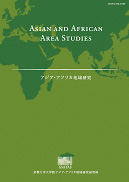Volume 23, Issue 1
Displaying 1-6 of 6 articles from this issue
- |<
- <
- 1
- >
- >|
Articles
-
2023Volume 23Issue 1 Pages 1-25
Published: September 30, 2023
Released on J-STAGE: October 27, 2023
Download PDF (1156K) -
2023Volume 23Issue 1 Pages 26-64
Published: September 30, 2023
Released on J-STAGE: October 27, 2023
Download PDF (1192K) -
2023Volume 23Issue 1 Pages 65-95
Published: September 30, 2023
Released on J-STAGE: October 27, 2023
Download PDF (1153K)
Research Note
-
2023Volume 23Issue 1 Pages 96-122
Published: September 30, 2023
Released on J-STAGE: October 27, 2023
Download PDF (1050K)
Book Reviews
-
2023Volume 23Issue 1 Pages 123-136
Published: September 30, 2023
Released on J-STAGE: October 27, 2023
Download PDF (907K)
Fieldwork News
-
2023Volume 23Issue 1 Pages 137-169
Published: September 30, 2023
Released on J-STAGE: October 27, 2023
Download PDF (1964K)
- |<
- <
- 1
- >
- >|
